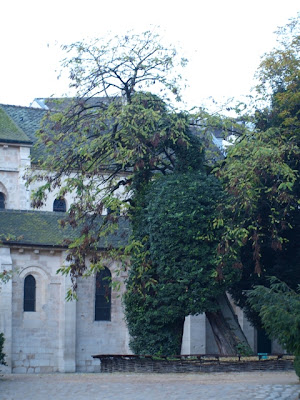Ancient Parisian acacia has a crise d’identité
It’s reputedly 400 years old this year, this False Acacia (Robinia pseudoacacia). Just shows what a little neglect can do: this
can’t be the best place to grow, with air pollution and soil compaction. On top
of that, folk wisdom is that ivy is bad for a tree and filling cracks in trees with
concrete and rubble is now out of favour.
Yes right now there is fruit on what may be the oldest tree
in Paris. Sometime in the Paris spring it had sex. I don’t know if the seed is
viable or not but it looked pretty good in the pod I examined.
If we are to believe the information in Square Rene Viviani
(just across the river from Notre Dame) the tree was planted here by Jean
Robin, during the reign of Henri IV, in 1601. Or perhaps 1602. The confusion
begins in Square Rene Viviani where the sign nailed to the tree says 1601 but
the guano-splattered blue sign at the base of the tree says 1602.
This could be
a simple mistake, or perhaps Robin dug the hole on New Year’s Eve and forgot to
bring the plant over until the next day. Of more import is that several
scholars have argued that this date is more than thirty years too early.
Either way, a century or so after the tree was planted the
famous Swedish botanist Carl Linnaeus named Robinia
after King Henri’s gardener, Jean Robin, apparently in recognition of him
bringing seeds of the False Acacia from Canada to France in 1600 or 1601. The
species was originally thought to belong to the genus Acacia, hence the common name.
An alternative story has the son of Jean Robin, Vespasian
Robin (1579-1662) bringing the seed to Paris from that famous country ‘who
knows where’ and planting this tree in 1636 or soon after. Vespasian collected
plants from all over the world, including North America. In this version
Linnaeus was just mixed up, or perhaps named it after both father and son.
Jean Robin (1550-1629) was gardener, or sometimes described
as arborist, to Henri IV, as well as his father and son I think. Lynda tells me
Henri IV was stabbed to death while stuck in Paris traffic, which I can believe
– I’d get road rage too if I had to commute on these roads.
Robin worked at the Jardin des Plantes when it was a royal
garden, and some versions of the story have the Robinia growing here until the 1980s rather than in Square Rene
Viviani (Vespasian also worked at the Jardin du Roi, as it was then, becoming
Head Gardener). Another story locates the tree at Place Dauphine, a small public
square (actually triangle) on the Île de la Cité (not opposite it, as is Square
Rene Viviani), where Vispasien was asked to establish a medicinal garden for
the university. The triangular square is at the opposite end of the island to where the next picture is taken, and Square Rene Viviani is just off screen to the left... There are a number of
elderly Robinias in the city vying for the title of oldest Paris tree.
Perhaps the 1636 version of the story is case of classic
English-French rivalry. False Acacia is first recorded in the UK in...1636! Jean
Robin was also mates with English plantsmen, such as John Gerard, and exchanged
plants across the channel. Kew Gardens
gets its first planting of this species in 1762, three years after the botanic
garden was established by Princess Augusta. The specimen was transplanted by
Lord Bute from the Duke of Argyll’s estate in Twickenham.
Growing on the lawn in front of the Orangery at the northern
end of Kew Gardens the False Acacia is one of a collection of six trees called ‘The
Old Lions’. The Old Lions remain from the oldest
documented plantings at Kew Gardens.
The False Acacia was one of the earliest North American
trees to reach Europe and is now widely planted in parks and gardens, as well
as making a nice living for itself as an invasive weed. I gather it reached the
peak of its UK popularity in the early nineteenth century thanks to some
encouraging words from William Cobbett.
Back in Paris, this 375, 399 or 400 year old tree, which may
or may not be the oldest planted tree alive in Paris today, is not the
prettiest specimen you’ll ever see. One part concrete, one part ivy and the
rest a scraggy Robinia pseudoacacia,
it was, at least, almost certainly
planted by the hand of Monsieur Robin.









Comments
So half of the things known about this false acacia are, uhm, false?